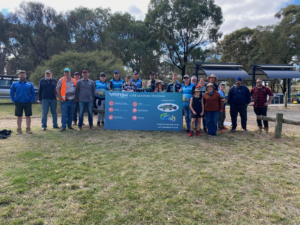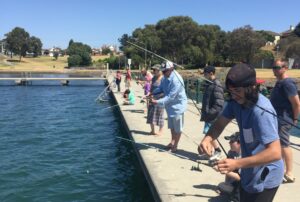February 29, 2024
Victorians are incredibly lucky to have such extensive and widespread coastlines that offer some of the most rewarding fishing experiences one can have.
Our picturesque Victorian coastlines provide some great opportunities to fish from rock ledges, submerged rocks and rock faces. Whilst rock fishing is a popular way to fish, there are serious dangers associated with it. Recreational fishers are encouraged to take precautions to ensure that rock fishing is enjoyed safely.
A two-year trial at ten high-risk locations along the Victorian coast that saw the Victorian Fisheries Authority make lifejackets mandatory to improve rock fishing safety has been completed. While the trial results are evaluated and longer-term arrangements are determined, the lifejacket mandate will remain in effect at the designated high-risk locations which includes new zones, extended zones and four existing sites.
FISHERIES (ROCK FISHING SAFETY) NOTICE 2024
The Victorian Fisheries Authority have issued the Fisheries (Rock Fishing Safety) Notice 2024 to make lifejackets mandatory at high-risk rock fishing locations along the Victorian coast to ensure the safety of rock fishers at high-risk locations across Victoria.
The key elements of the final Notice are as follows:
i. Adults rock fishers will be required to wear a Level 50S or greater lifejacket (Type 3 or greater) at 10 high-risk sites.
ii. Children under the age of 12 will be required to wear a Level 100 lifejacket (Type 1 lifejacket) at 10 high-risk sites.
iii. Lifejackets must be the correct size, must be in good working order and must be worn correctly (all zippers, buckles and tapes must be correctly secured).
iv. Lifejackets that solely rely on oral inflation will not be permitted.
v. Spear fishers and divers are exempt from the lifejacket requirements at the 10 high-risk sites.
The designated high-risk locations where lifejackets must be worn outlined in the Notice are:
- Cape Bridgewater blowholes, near Cape Bridgewater
- Sheoak Falls, near Lorne
- Artillery Rocks, near Lorne
- Jump Rocks, near Lorne
- Point Nepean to West Head, near Flinders
- Cowries Rock Platform, Phillip Island
- Kitty Miller Bay, Phillip Island
- Pyramid Rocks, Phillip Island
- Sunderland Bay, Phillip Island
- Bore Beach (near San Remo) to Kilcunda (including Punchbowl Rocks)
View maps of the locations here.
What type of lifejacket do I need?
Your lifejacket must comply with the Australian Standard (AS 4758) and be:
- a Level 50S lifejacket or greater.
- your correct size.
- in good working order. Ensure buckles are working and straps are not frayed.
- worn correctly with all zippers, buckles and tapes correctly secured.
- regularly serviced.
Lifejackets that solely rely on oral inflation cannot be used.
What type of lifejacket do children need?
Any child under your supervision must wear a lifejacket even if they are not fishing. Children’s lifejackets must:
- comply with the Australian Standard (AS 4758)
and - be a Level 100 lifejacket or greater.
ROCK FISHING SAFETY
Life Saving Victoria along with stakeholders, VRFish and the Victorian Fisheries Authority, worked on the following guidelines through the rock safety project to reduce the amount of drownings as a result of rock fishing.
For recfishers who enjoy rock fishing, follow these safety guidelines to ensure that you enjoy all the benefits of rock fishing without any of the unnecessary risk.
- Always wear a life jacket and never fish alone. Inform others of your fishing plans so that search and rescue know where to look if things turn bad.
- Wear light clothing; appropriate footwear and carry safety gear, a rope and a float are a couple of the essentials.
- Never fish in exposed areas during rough or large seas.
- Observe first, fish later. This will ensure that you are aware of the conditions you will be fishing in and can properly prepare.
- Plan an escape route in case you are washed in.
- Stay alert at all times. Victoria is known for its unpredictability with weather conditions, changing from good to bad in a heartbeat.
- Ask advice from locals who know the area.
VITAL WEATHER SAFETY CHECKS BEFORE ROCK FISHING
Before you go rock fishing, it’s important to check the weather via the Bureau of Meteorology (BOM). The BOM is a great resource where you can check the five vital weather safety checks before you head out rock fishing.
The BOM’s five vital weather safety checks are:
- Wave conditions
- Tide times
- Wind conditions
- Marine warnings
- Changing weather
Visit the BOM’s website for information on using MetEye for rock fishing. Rock fishers can use MetEye to find information on forecast waves, winds and weather for an area or specific locations.








